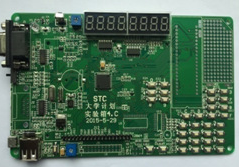a. Nickel: The nickel plating used for printed circuit boards is divided into semi-bright nickel (also called low-stress nickel or dumb nickel) and bright nickel. It is mainly used as the bottom layer of gold-plated board or plug gold-plated, and can also be used as a surface layer as required. The thickness of the plating layer is not less than 2~2.5 μm in accordance with the IPC-6012 (1996) standard. The nickel plating layer should have the characteristics of uniformity and fineness, low porosity, good ductility, etc., and the low-stress nickel should have the function of being suitable for brazing or pressure welding.
b. Gold: The gold-plated layer used in the production of printed circuit boards is divided into two types; the plate surface is gold-plated and the plug is gold-plated.
1) Gold plating on the board surface: The gold plating layer on the board surface is 24K pure gold with a columnar structure, which has excellent conductivity and solderability. The thickness of the coating is 0.01~0.05μm.

The gold-plated layer on the board is based on low-stress nickel or bright nickel. The thickness of the nickel-plated layer is 3-51xm. The nickel-plated layer acts as a barrier between gold and copper. It can prevent the mutual diffusion of gold and copper. Prevent copper from penetrating to the gold surface. The presence of the nickel layer is equivalent to increasing the hardness of the gold plating layer.
The gold plating layer on the board surface is not only a protective layer for alkaline etching, but also the final surface plating layer for IC aluminum wire bonding and button type printed circuit boards.
2) Gold-plated plug: Gold-plated plug is also called hard gold, commonly known as "golden finger". It is an alloy coating containing Co, Ni, Fe, Sb and other alloying elements, and its hardness and wear resistance are higher than pure gold coatings. The hard gold plating layer has a layered structure. The gold-plated layer of plugs used for printed circuit boards is generally 0.5 to 1.5 μm or thicker. The content of alloying elements is less than or equal to 0.2%. Gold-plated plugs are used for high-stability and high-reliability electrical contact connections; requirements for plating thickness, wear resistance, and porosity are required.
The hard gold plating layer uses low-stress nickel as a barrier layer to prevent mutual diffusion between gold and copper. In order to improve the bonding force of the hard gold coating and reduce the porosity, and to protect the plating solution and reduce pollution, a pure gold layer of 0.02 to 0.05 p, m should be plated between the nickel layer and the hard gold layer.
c. Tin: Electroless tinning on bare copper PCBs is also a solderable coating that has received widespread attention in recent years.
The electroless tin plating on the copper substrate is essentially chemical immersion tin, which is a substitution reaction between copper and complex tin ions in the plating solution to form a tin plating layer. When the copper surface is completely covered by tin, the reaction stops.
d. Silver: The electroless silver layer can be both soldered and "bonded" (bonding), so it has received widespread attention. The nature of the electroless silver plating layer is also immersion silver. The standard electrode potential of copper is 0Cu+/Cu=0.51 V, and the standard electrode potential of silver is 0Ag+/Ag=0.799 V. Therefore, copper can replace the silver ions in the solution. The deposited silver layer is formed on the surface: Ag++Cu-Cu++Ag to control the reaction speed, the Ag+ in the solution will exist in the state of complex ions. When the copper surface is completely covered or the Cu in the solution reaches a certain concentration, the reaction ends.
e. Palladium: Electroless Pd is an ideal copper and nickel protective layer on PCB circuit boards. It can be soldered and "bonded". It can be directly plated on copper, and because Pd has autocatalytic ability, the plating layer can be thick. Its thickness can reach 0.08~0.2μm, and it can also be plated on the electroless nickel coating. The Pd layer has high heat resistance, stability, and can withstand multiple thermal shocks.
When assembling and soldering, for Ni/Au plating, when the gold-plated layer is in contact with the molten solder, the gold is melted to form AuSn4 in the solder. When the weight ratio of the solder reaches 3%, the solder will become brittle and affect the reliability of the solder joint. The molten solder does not form a compound with Pd, and Pd floats on the surface of the solder and is very stable.
As the price of Pd is more expensive than gold, its application is limited to a certain extent. With the improvement of IC integration and the advancement of assembly technology, electroless Pd plating will play a more effective role in chip pole assembly (CSP).